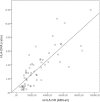Preliminary results in quantitation of HLA-DRA by real-time PCR: a promising approach to identify immunosuppression in sepsis
- PMID: 24093602
- PMCID: PMC4057202
- DOI: 10.1186/cc13046
Preliminary results in quantitation of HLA-DRA by real-time PCR: a promising approach to identify immunosuppression in sepsis
Abstract
Introduction: Reduced monocyte human leukocyte antigen (mHLA)-DR surface expression in the late phase of sepsis is postulated as a general biomarker of sepsis-induced immunosuppression and an independent predictor of nosocomial infections.
Methods: Fifty-nine patients with sepsis and blood culture growing pathogenic bacteria were studied. Blood samples were collected at day 1 or 2 after admission, for measurement of mHLA-DR by flow cytometry and mRNA expression of HLA-DRA and class II transactivator (CIITA) by qRT-PCR. Blood samples from blood donors were used as controls (n = 30).
Results: A significant reduced expression of mHLA-DR, HLA-DRA, and CIITA was seen in septic patients compared with controls. HLA-DRA mRNA level in whole blood was highly correlated with surface expression of mHLA-DR.
Conclusions: Patients with sepsis display a diminished expression of HLA-DR at the monocyte surface as well as in the gene expression at the mRNA level. The mRNA expression level of HLA-DRA monitored by qRT-PCR correlates highly with surface expression of HLA-DR and appears to be a possible future biomarker for evaluation of immunosuppression in sepsis.
Figures



Comment in
-
Monocyte HLA-DR in sepsis: shall we stop following the flow?Crit Care. 2014 Jan 6;18(1):102. doi: 10.1186/cc13179. Crit Care. 2014. PMID: 24393356 Free PMC article.
Similar articles
-
Quantitative Real-Time Polymerase Chain Reaction Measurement of HLA-DRA Gene Expression in Whole Blood Is Highly Reproducible and Shows Changes That Reflect Dynamic Shifts in Monocyte Surface HLA-DR Expression during the Course of Sepsis.PLoS One. 2016 May 4;11(5):e0154690. doi: 10.1371/journal.pone.0154690. eCollection 2016. PLoS One. 2016. PMID: 27144640 Free PMC article.
-
Human leucocyte antigen (HLA-DR) gene expression is reduced in sepsis and correlates with impaired TNFα response: A diagnostic tool for immunosuppression?PLoS One. 2017 Aug 3;12(8):e0182427. doi: 10.1371/journal.pone.0182427. eCollection 2017. PLoS One. 2017. PMID: 28771573 Free PMC article.
-
Messenger RNA expression of major histocompatibility complex class II genes in whole blood from septic shock patients.Crit Care Med. 2005 Jan;33(1):31-8; discussion 236-7. doi: 10.1097/01.ccm.0000150958.20209.a3. Crit Care Med. 2005. PMID: 15644645
-
Utility of monocyte HLA-DR and rationale for therapeutic GM-CSF in sepsis immunoparalysis.Front Immunol. 2023 Feb 7;14:1130214. doi: 10.3389/fimmu.2023.1130214. eCollection 2023. Front Immunol. 2023. PMID: 36825018 Free PMC article. Review.
-
Monocyte HLA-DR Measurement by Flow Cytometry in COVID-19 Patients: An Interim Review.Cytometry A. 2020 Dec;97(12):1217-1221. doi: 10.1002/cyto.a.24249. Epub 2020 Nov 4. Cytometry A. 2020. PMID: 33125816 Review.
Cited by
-
Smoking, Gender, and Overweight Are Important Influencing Factors on Monocytic HLA-DR before and after Major Cancer Surgery.Biomed Res Int. 2017;2017:5216562. doi: 10.1155/2017/5216562. Epub 2017 Aug 8. Biomed Res Int. 2017. PMID: 29104871 Free PMC article. Clinical Trial.
-
Pediatric Sepsis - Sailing the Unchartered Waters with Omics.Indian J Crit Care Med. 2024 Sep;28(9):818-819. doi: 10.5005/jp-journals-10071-24799. Epub 2024 Aug 31. Indian J Crit Care Med. 2024. PMID: 39360198 Free PMC article.
-
The non-canonical inflammasome activators Caspase-4 and Caspase-5 are differentially regulated during immunosuppression-associated organ damage.Front Immunol. 2023 Dec 1;14:1239474. doi: 10.3389/fimmu.2023.1239474. eCollection 2023. Front Immunol. 2023. PMID: 38106412 Free PMC article.
-
Impact of human sepsis on CCCTC-binding factor associated monocyte transcriptional response of Major Histocompatibility Complex II components.PLoS One. 2018 Sep 13;13(9):e0204168. doi: 10.1371/journal.pone.0204168. eCollection 2018. PLoS One. 2018. PMID: 30212590 Free PMC article.
-
Dynamics of monocytic HLA-DR expression differs between bacterial etiologies during the course of bloodstream infection.PLoS One. 2018 Feb 21;13(2):e0192883. doi: 10.1371/journal.pone.0192883. eCollection 2018. PLoS One. 2018. PMID: 29466395 Free PMC article.
References
-
- Dellinger RP, Levy MM, Rhodes A, Annane D, Gerlach H, Opal SM, Sevransky JE, Sprung CL, Douglas IS, Jaeschke R, Osborn TM, Nunnally ME, Townsend SR, Reinhart K, Kleinpell RM, Angus DC, Deutschman CS, Machado FR, Rubenfeld GD, Webb SA, Beale RJ, Vincent JL, Moreno R. Surviving Sepsis Campaign Guidelines Committee including the Pediatric S. Surviving sepsis campaign: international guidelines for management of severe sepsis and septic shock: 2012. Crit Care Med. 2013;17:580–637. doi: 10.1097/CCM.0b013e31827e83af. - DOI - PubMed
-
- Levy MM, Dellinger RP, Townsend SR, Linde-Zwirble WT, Marshall JC, Bion J, Schorr C, Artigas A, Ramsay G, Beale R, Parker MM, Gerlach H, Reinhart K, Silva E, Harvey M, Regan S, Angus DC. The Surviving Sepsis Campaign: results of an international guideline-based performance improvement program targeting severe sepsis. Intensive Care Med. 2010;17:222–231. doi: 10.1007/s00134-009-1738-3. - DOI - PMC - PubMed
Publication types
MeSH terms
Substances
LinkOut - more resources
Full Text Sources
Other Literature Sources
Medical
Research Materials

